北师大版(2019)选择性必修 第一册 Unit 3 Conservation Viewing Workshop & Reading Club课件(35张PPT含视频)
文档属性
| 名称 | 北师大版(2019)选择性必修 第一册 Unit 3 Conservation Viewing Workshop & Reading Club课件(35张PPT含视频) | 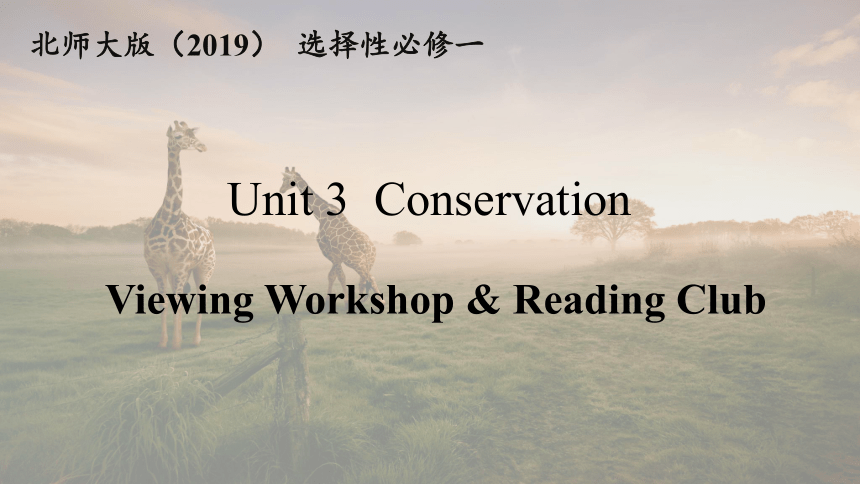 | |
| 格式 | pptx | ||
| 文件大小 | 62.4MB | ||
| 资源类型 | 教案 | ||
| 版本资源 | 北师大版(2019) | ||
| 科目 | 英语 | ||
| 更新时间 | 2023-08-20 15:45:11 | ||
图片预览


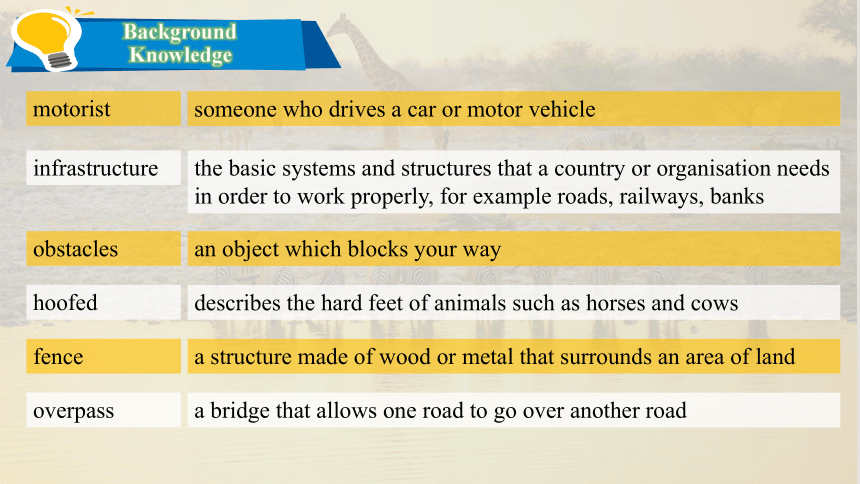


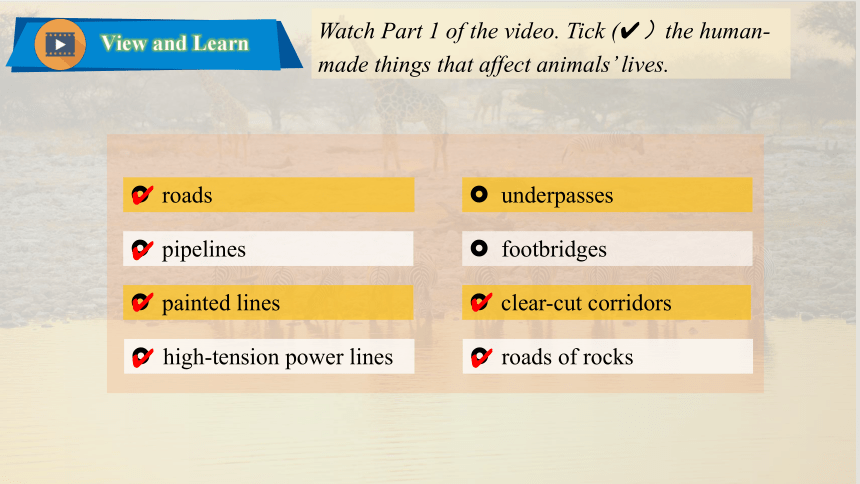
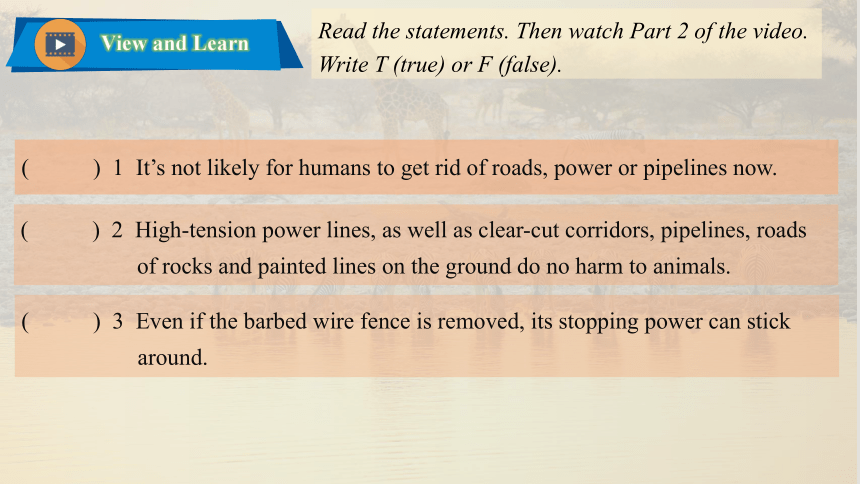
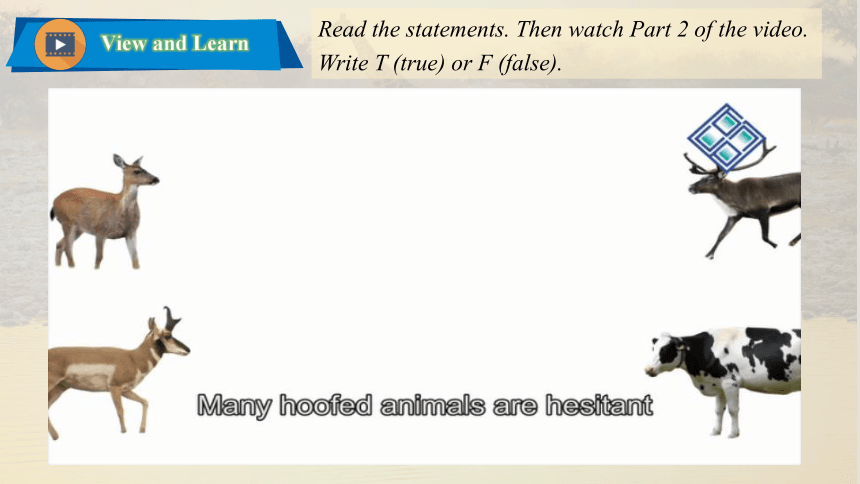

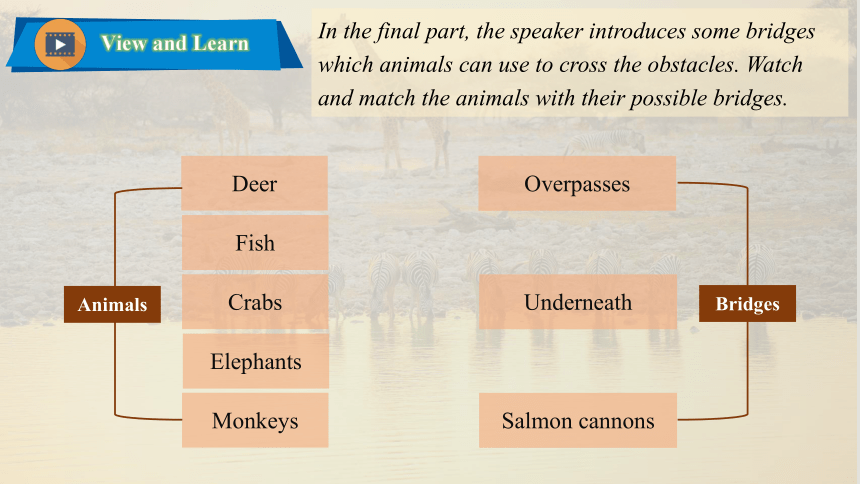
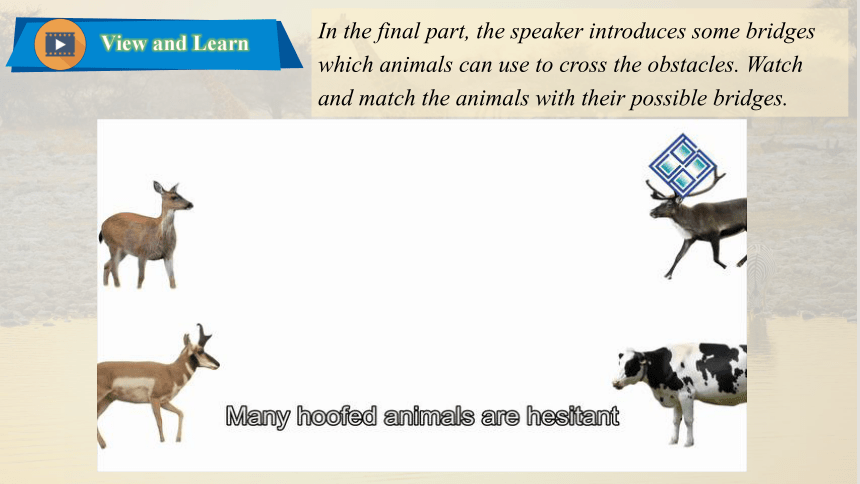
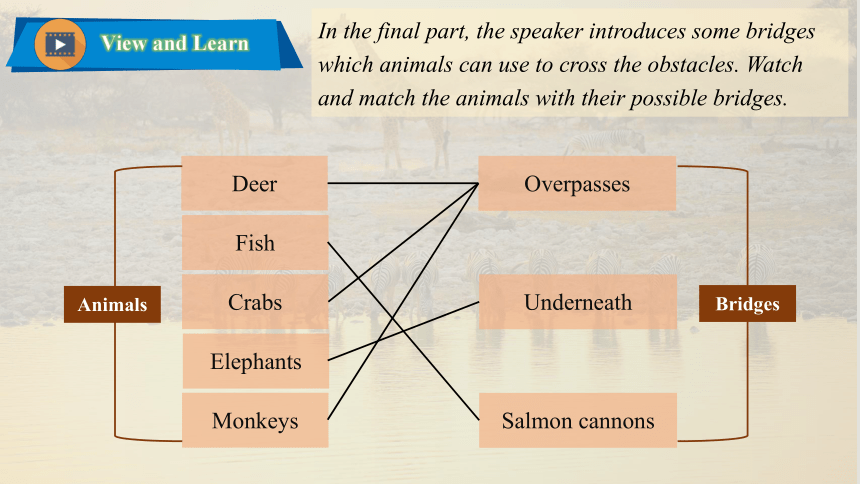
文档简介
(共35张PPT)
Unit 3 Conservation
Viewing Workshop & Reading Club
北师大版(2019) 选择性必修一
Part 1 Viewing Workshop
Crazy Bridges for Animals
北师大版(2019) 选择性必修一
Background Knowledge
motorist
someone who drives a car or motor vehicle
infrastructure
the basic systems and structures that a country or organisation needs in order to work properly, for example roads, railways, banks
obstacles
an object which blocks your way
hoofed
describes the hard feet of animals such as horses and cows
fence
a structure made of wood or metal that surrounds an area of land
overpass
a bridge that allows one road to go over another road
Watch Part 1 of the video. Tick ( )the human-made things that affect animals’ lives.
roads
clear-cut corridors
underpasses
pipelines
footbridges
high-tension power lines
painted lines
roads of rocks
View and Learn
View and Learn
Watch Part 1 of the video. Tick ( )the human-made things that affect animals’ lives.
Watch Part 1 of the video. Tick ( )the human-made things that affect animals’ lives.
View and Learn
roads
clear-cut corridors
underpasses
pipelines
footbridges
high-tension power lines
painted lines
roads of rocks
Read the statements. Then watch Part 2 of the video. Write T (true) or F (false).
( ) 1 It’s not likely for humans to get rid of roads, power or pipelines now.
View and Learn
( ) 2 High-tension power lines, as well as clear-cut corridors, pipelines, roads
of rocks and painted lines on the ground do no harm to animals.
( ) 3 Even if the barbed wire fence is removed, its stopping power can stick
around.
View and Learn
Read the statements. Then watch Part 2 of the video. Write T (true) or F (false).
Read the statements. Then watch Part 2 of the video. Write T (true) or F (false).
( ) 1 It’s not likely for humans to get rid of roads, power or pipelines now.
View and Learn
( ) 2 High-tension power lines, as well as clear-cut corridors, pipelines, roads
of rocks and painted lines on the ground do no harm to animals.
( ) 3 Even if the barbed wire fence is removed, its stopping power can stick
around.
T
F
T
In the final part, the speaker introduces some bridges which animals can use to cross the obstacles. Watch and match the animals with their possible bridges.
Deer
View and Learn
Fish
Crabs
Elephants
Monkeys
Overpasses
Underneath
Salmon cannons
Animals
Bridges
View and Learn
In the final part, the speaker introduces some bridges which animals can use to cross the obstacles. Watch and match the animals with their possible bridges.
In the final part, the speaker introduces some bridges which animals can use to cross the obstacles. Watch and match the animals with their possible bridges.
Deer
View and Learn
Fish
Crabs
Elephants
Monkeys
Overpasses
Underneath
Salmon cannons
Animals
Bridges
Watch the whole video. Read the first part of statement below and find a suitable ending from the box on the right to make each statement complete.
1 Unintentional fences that may
look harmless to us
View and Learn
2 If many animals are stranded
on one side,
3 Even when we remove
physical barriers,
a animals still won’t cross the divide.
b they will become isolated from food,
mates and protection.
c are some of the most effective animal
barriers.
View and Learn
Watch the whole video. Read the first part of statement below and find a suitable ending from the box on the right to make each statement complete.
Watch the whole video. Read the first part of statement below and find a suitable ending from the box on the right to make each statement complete.
1 Unintentional fences that may
look harmless to us
View and Learn
2 If many animals are stranded
on one side,
3 Even when we remove
physical barriers
a animals still won’t cross the divide.
b they will become isolated from food,
mates and protection.
c are some of the most effective animal
barriers.
Part 2 Reading Club 1
World Heritage Sites in China
北师大版(2019) 选择性必修一
重点单词
1.______________ n. 委员会
2.______________ n. 庙宇,寺院
3.______________ 孔子
4.______________ n. 纪念馆;纪念碑
adj. (对逝者)纪念的,追悼的
5.______________ vt. 雕,刻
6.______________ n. 谷,山谷
committee
temple
Confucius
memorial
carve
valley
重点单词
7.______________ adj. 景色优美的
8.______________ adj. 古老的;历史上重要的
9.______________ n. 遗产
10.______________ n. 宅邸;大厦
11.______________ n. 翡翠
12.______________ n. 小巷
scenic
historic
heritage
mansion
jade
alley
Background Knowledge
heritage
features belonging to the culture of a particular society, such as traditions, languages, or buildings, that were created in the past and still have historical importance
natural wonder
a natural object or place that causes a feeling of great surprise and admiration
natural beauty
an attractive quality that gives pleasure to those who experience it or think about it
General Understanding
Read the texts. Answer these questions.
1 Who decides which place will be given the title of “ World Heritage Site”
2 What are the features of the sites mentioned in the texts
World Heritage Sites in China
The official title of “World Heritage Site” is given by the United Nations Educational, Scientific and Cultural Organisation (UNESCO) committee to places in the world that are outstanding examples of cultural or natural history. Up to 2019, there are 55 world heritage sites in China, which has the same number of sites as Italy. Here are three of them.
General Understanding
Read the texts. Answer these questions.
The Temple and Mansion of Confucius
This site is located in Qufu, Shandong Province, and is a memorial to Confucius. The site is huge. On the ground, there are more than 900 halls and rooms. The building that people visit most is the Temple of Confucius. Besides the temple, visitors can enjoy the grounds outside, where there are more than 1,000 stone tablets and over 100,000 tombs.
General Understanding
Read the texts. Answer these questions.
The Old Town of Lijiang
This site is a few hours bus-ride away from the ancient city of Dali in Yunnan Province. Surrounded by fields, mountains and rivers, the Old Town of Lijiang looks like a jade ink stone in spring and summer.
Each year, many foreign tourists visit the Old Town, and the place is like “Venice in the East” to them. There are narrow alleys, pretty streams, small stone bridges and houses with carved doors and painted windows.
General Understanding
Read the texts. Answer these questions.
Jiuzhaigou Valley Scenic and Historic Interest Area
This area, north of Sichuan Province, is a unique natural wonder. Every year, visitors from all over the world come to admire the mountains, lakes, streams, trees, underground springs and waterfalls, which make Jiuzhaigou Valley an area of outstanding natural beauty.
The valley is also home to many protected species of plants and endangered animals.
General Understanding
Read the texts. Answer these questions.
1 Who decides which place will be given the title of “ World Heritage Site”
The United Nations Educational, Scientific and Cultural Organisation (UNESCO)
decides.
2 What are the features of the sites mentioned in the texts
The Temple and Mansion of Confucius is a memorial to Confucius. The site is huge.
The Old Town of Lijiang looks like a jade ink stone in spring and summer.
Jiuzhaigou Valley Scenic and Historic Interest Area is a unique natural wonder.
Part 3 Reading Club 2
Nature Is Turning on US
北师大版(2019) 选择性必修一
重点单词
1.______________ n. 雷暴
2.______________ n. 台风
3.______________ adj. 农业的
4.______________ adj. 大西洋的
thunderstorm
typhoon
agricultural
Atlantic
Background Knowledge
grand
important and large in degree
rainfall
rain, or the amount of rain that falls
to turn on sb
to cause harm to someone in a sudden and unexpected way
overpopulation
if a country or city, etc. is overpopulated, it has too many people for the amount of food, materials, and space available there
developing world
a country with little industrial and economic activity and where people generally have low incomes
General Understanding
Complete the diagram with facts about natural disasters around the world.
Natural
Disasters
Earthquakes
central Italy, in 2016
Hurricanes and
typhoons
Reduced rainfall
Volcanic eruptions
Landslides
General Understanding
Complete the diagram with facts about natural disasters around the world.
NATURE IS TURNING ON US
In the last few years, we have seen environmental disasters on a grand scale, and experts are predicting worse to come. Jin Li reports on our Earth’s changeable weather patterns.
Thunderstorms, floods, earthquakes, typhoons, volcanic eruptions, tsunamis, and forest fires have become increasingly common. There have been terrible floods in Asia, Africa, America and Oceania. Storms have been getting worse everywhere too, with more hurricanes hitting the US and Central America. Reduced rainfall has affected Africa for years, with severe droughts in Somalia and Kenya in 2017, as well as many other zones becoming drier.
General Understanding
Complete the diagram with facts about natural disasters around the world.
Reduced rainfall in Canada resulted in a huge forest fire in May 2016. Volcanic eruptions and earthquakes have always been a threat. In 2016, there were three volcanic eruptions at almost the same time in Indonesia. There have been serious earthquakes in many parts of Asia, Europe and South America. A massive earthquake hit central Italy in August 2016, killing at least 247 people.
So why is nature beginning to turn on us One answer is overpopulation. The population of the world is growing at the rate of 10,000 people an hour, nearly 90 million a year. Most of the growth is in the developing world. Poor people in agricultural areas often move to the cities. They build homes from whatever materials they can find. These homes can easily collapse during earthquakes or slip and slide downhill in landslides, especially after heavy rain.
General Understanding
Complete the diagram with facts about natural disasters around the world.
On top of that, there is the added aspect of global warming. This has mainly been caused by the huge amounts of carbon dioxide produced by factories and vehicles. The destruction of the world’s forests plays a part, too. As a result, a hotter ocean causes stronger winds. Atlantic hurricanes are 40% stronger now than they were 30 years ago.
Landslides and earthquakes are even more dangerous now than in the past because around half of the world’s population now live in cities. Many people in cities and towns in South America and Asia are at risk from landslides. In April 2017, the city of Mocoa in Colombia was hit by a landslide, leaving many dead and injured. A great number of people live at risk from earthquakes too. These have claimed more than 1.6 million lives in the last hundred years.
General Understanding
Complete the diagram with facts about natural disasters around the world.
Most disaster experts believe that things could get a lot worse. Professor Hou Ming of Peking University studies volcanoes. He warns that the world has not seen the worst yet. The worst eruption in human history was probably Mt Tambora in 1815, in Indonesia. Dust from the volcano rolled across the Earth’s skies. There was no summer in Europe and America the following year. But evidence shows that 73,000 years ago there was a much greater eruption. “It reduced temperatures by maybe 6℃ in some places, and the whole planet was sent into winter for years. And there are about two of these events every 100,000 years...”
General Understanding
Complete the diagram with facts about natural disasters around the world.
Earthquakes
central Italy, in 2016
Asia, Europe and South
America
Hurricanes and typhoons
US
Central America
Reduced rainfall
in Somalia and Kenya, in 2017
Canada in 2016
Volcanic eruptions
Indonesia, in 2016
Mt Tambora in Indonesia, in 1815
Landslides
Mocoa in Colombia, in 2017
Natural
Disasters
General Understanding
According to the author, why is nature turning on us
First, overpopulation results in heavy building using local materials without proper planning, which can contribute to landslides or collapse during earthquakes.
Next, global warming, caused by factories and vehicles, and the destruction of forests cause climate change and extreme weather conditions.
Thank You
Unit 3 Conservation
Viewing Workshop & Reading Club
北师大版(2019) 选择性必修一
Part 1 Viewing Workshop
Crazy Bridges for Animals
北师大版(2019) 选择性必修一
Background Knowledge
motorist
someone who drives a car or motor vehicle
infrastructure
the basic systems and structures that a country or organisation needs in order to work properly, for example roads, railways, banks
obstacles
an object which blocks your way
hoofed
describes the hard feet of animals such as horses and cows
fence
a structure made of wood or metal that surrounds an area of land
overpass
a bridge that allows one road to go over another road
Watch Part 1 of the video. Tick ( )the human-made things that affect animals’ lives.
roads
clear-cut corridors
underpasses
pipelines
footbridges
high-tension power lines
painted lines
roads of rocks
View and Learn
View and Learn
Watch Part 1 of the video. Tick ( )the human-made things that affect animals’ lives.
Watch Part 1 of the video. Tick ( )the human-made things that affect animals’ lives.
View and Learn
roads
clear-cut corridors
underpasses
pipelines
footbridges
high-tension power lines
painted lines
roads of rocks
Read the statements. Then watch Part 2 of the video. Write T (true) or F (false).
( ) 1 It’s not likely for humans to get rid of roads, power or pipelines now.
View and Learn
( ) 2 High-tension power lines, as well as clear-cut corridors, pipelines, roads
of rocks and painted lines on the ground do no harm to animals.
( ) 3 Even if the barbed wire fence is removed, its stopping power can stick
around.
View and Learn
Read the statements. Then watch Part 2 of the video. Write T (true) or F (false).
Read the statements. Then watch Part 2 of the video. Write T (true) or F (false).
( ) 1 It’s not likely for humans to get rid of roads, power or pipelines now.
View and Learn
( ) 2 High-tension power lines, as well as clear-cut corridors, pipelines, roads
of rocks and painted lines on the ground do no harm to animals.
( ) 3 Even if the barbed wire fence is removed, its stopping power can stick
around.
T
F
T
In the final part, the speaker introduces some bridges which animals can use to cross the obstacles. Watch and match the animals with their possible bridges.
Deer
View and Learn
Fish
Crabs
Elephants
Monkeys
Overpasses
Underneath
Salmon cannons
Animals
Bridges
View and Learn
In the final part, the speaker introduces some bridges which animals can use to cross the obstacles. Watch and match the animals with their possible bridges.
In the final part, the speaker introduces some bridges which animals can use to cross the obstacles. Watch and match the animals with their possible bridges.
Deer
View and Learn
Fish
Crabs
Elephants
Monkeys
Overpasses
Underneath
Salmon cannons
Animals
Bridges
Watch the whole video. Read the first part of statement below and find a suitable ending from the box on the right to make each statement complete.
1 Unintentional fences that may
look harmless to us
View and Learn
2 If many animals are stranded
on one side,
3 Even when we remove
physical barriers,
a animals still won’t cross the divide.
b they will become isolated from food,
mates and protection.
c are some of the most effective animal
barriers.
View and Learn
Watch the whole video. Read the first part of statement below and find a suitable ending from the box on the right to make each statement complete.
Watch the whole video. Read the first part of statement below and find a suitable ending from the box on the right to make each statement complete.
1 Unintentional fences that may
look harmless to us
View and Learn
2 If many animals are stranded
on one side,
3 Even when we remove
physical barriers
a animals still won’t cross the divide.
b they will become isolated from food,
mates and protection.
c are some of the most effective animal
barriers.
Part 2 Reading Club 1
World Heritage Sites in China
北师大版(2019) 选择性必修一
重点单词
1.______________ n. 委员会
2.______________ n. 庙宇,寺院
3.______________ 孔子
4.______________ n. 纪念馆;纪念碑
adj. (对逝者)纪念的,追悼的
5.______________ vt. 雕,刻
6.______________ n. 谷,山谷
committee
temple
Confucius
memorial
carve
valley
重点单词
7.______________ adj. 景色优美的
8.______________ adj. 古老的;历史上重要的
9.______________ n. 遗产
10.______________ n. 宅邸;大厦
11.______________ n. 翡翠
12.______________ n. 小巷
scenic
historic
heritage
mansion
jade
alley
Background Knowledge
heritage
features belonging to the culture of a particular society, such as traditions, languages, or buildings, that were created in the past and still have historical importance
natural wonder
a natural object or place that causes a feeling of great surprise and admiration
natural beauty
an attractive quality that gives pleasure to those who experience it or think about it
General Understanding
Read the texts. Answer these questions.
1 Who decides which place will be given the title of “ World Heritage Site”
2 What are the features of the sites mentioned in the texts
World Heritage Sites in China
The official title of “World Heritage Site” is given by the United Nations Educational, Scientific and Cultural Organisation (UNESCO) committee to places in the world that are outstanding examples of cultural or natural history. Up to 2019, there are 55 world heritage sites in China, which has the same number of sites as Italy. Here are three of them.
General Understanding
Read the texts. Answer these questions.
The Temple and Mansion of Confucius
This site is located in Qufu, Shandong Province, and is a memorial to Confucius. The site is huge. On the ground, there are more than 900 halls and rooms. The building that people visit most is the Temple of Confucius. Besides the temple, visitors can enjoy the grounds outside, where there are more than 1,000 stone tablets and over 100,000 tombs.
General Understanding
Read the texts. Answer these questions.
The Old Town of Lijiang
This site is a few hours bus-ride away from the ancient city of Dali in Yunnan Province. Surrounded by fields, mountains and rivers, the Old Town of Lijiang looks like a jade ink stone in spring and summer.
Each year, many foreign tourists visit the Old Town, and the place is like “Venice in the East” to them. There are narrow alleys, pretty streams, small stone bridges and houses with carved doors and painted windows.
General Understanding
Read the texts. Answer these questions.
Jiuzhaigou Valley Scenic and Historic Interest Area
This area, north of Sichuan Province, is a unique natural wonder. Every year, visitors from all over the world come to admire the mountains, lakes, streams, trees, underground springs and waterfalls, which make Jiuzhaigou Valley an area of outstanding natural beauty.
The valley is also home to many protected species of plants and endangered animals.
General Understanding
Read the texts. Answer these questions.
1 Who decides which place will be given the title of “ World Heritage Site”
The United Nations Educational, Scientific and Cultural Organisation (UNESCO)
decides.
2 What are the features of the sites mentioned in the texts
The Temple and Mansion of Confucius is a memorial to Confucius. The site is huge.
The Old Town of Lijiang looks like a jade ink stone in spring and summer.
Jiuzhaigou Valley Scenic and Historic Interest Area is a unique natural wonder.
Part 3 Reading Club 2
Nature Is Turning on US
北师大版(2019) 选择性必修一
重点单词
1.______________ n. 雷暴
2.______________ n. 台风
3.______________ adj. 农业的
4.______________ adj. 大西洋的
thunderstorm
typhoon
agricultural
Atlantic
Background Knowledge
grand
important and large in degree
rainfall
rain, or the amount of rain that falls
to turn on sb
to cause harm to someone in a sudden and unexpected way
overpopulation
if a country or city, etc. is overpopulated, it has too many people for the amount of food, materials, and space available there
developing world
a country with little industrial and economic activity and where people generally have low incomes
General Understanding
Complete the diagram with facts about natural disasters around the world.
Natural
Disasters
Earthquakes
central Italy, in 2016
Hurricanes and
typhoons
Reduced rainfall
Volcanic eruptions
Landslides
General Understanding
Complete the diagram with facts about natural disasters around the world.
NATURE IS TURNING ON US
In the last few years, we have seen environmental disasters on a grand scale, and experts are predicting worse to come. Jin Li reports on our Earth’s changeable weather patterns.
Thunderstorms, floods, earthquakes, typhoons, volcanic eruptions, tsunamis, and forest fires have become increasingly common. There have been terrible floods in Asia, Africa, America and Oceania. Storms have been getting worse everywhere too, with more hurricanes hitting the US and Central America. Reduced rainfall has affected Africa for years, with severe droughts in Somalia and Kenya in 2017, as well as many other zones becoming drier.
General Understanding
Complete the diagram with facts about natural disasters around the world.
Reduced rainfall in Canada resulted in a huge forest fire in May 2016. Volcanic eruptions and earthquakes have always been a threat. In 2016, there were three volcanic eruptions at almost the same time in Indonesia. There have been serious earthquakes in many parts of Asia, Europe and South America. A massive earthquake hit central Italy in August 2016, killing at least 247 people.
So why is nature beginning to turn on us One answer is overpopulation. The population of the world is growing at the rate of 10,000 people an hour, nearly 90 million a year. Most of the growth is in the developing world. Poor people in agricultural areas often move to the cities. They build homes from whatever materials they can find. These homes can easily collapse during earthquakes or slip and slide downhill in landslides, especially after heavy rain.
General Understanding
Complete the diagram with facts about natural disasters around the world.
On top of that, there is the added aspect of global warming. This has mainly been caused by the huge amounts of carbon dioxide produced by factories and vehicles. The destruction of the world’s forests plays a part, too. As a result, a hotter ocean causes stronger winds. Atlantic hurricanes are 40% stronger now than they were 30 years ago.
Landslides and earthquakes are even more dangerous now than in the past because around half of the world’s population now live in cities. Many people in cities and towns in South America and Asia are at risk from landslides. In April 2017, the city of Mocoa in Colombia was hit by a landslide, leaving many dead and injured. A great number of people live at risk from earthquakes too. These have claimed more than 1.6 million lives in the last hundred years.
General Understanding
Complete the diagram with facts about natural disasters around the world.
Most disaster experts believe that things could get a lot worse. Professor Hou Ming of Peking University studies volcanoes. He warns that the world has not seen the worst yet. The worst eruption in human history was probably Mt Tambora in 1815, in Indonesia. Dust from the volcano rolled across the Earth’s skies. There was no summer in Europe and America the following year. But evidence shows that 73,000 years ago there was a much greater eruption. “It reduced temperatures by maybe 6℃ in some places, and the whole planet was sent into winter for years. And there are about two of these events every 100,000 years...”
General Understanding
Complete the diagram with facts about natural disasters around the world.
Earthquakes
central Italy, in 2016
Asia, Europe and South
America
Hurricanes and typhoons
US
Central America
Reduced rainfall
in Somalia and Kenya, in 2017
Canada in 2016
Volcanic eruptions
Indonesia, in 2016
Mt Tambora in Indonesia, in 1815
Landslides
Mocoa in Colombia, in 2017
Natural
Disasters
General Understanding
According to the author, why is nature turning on us
First, overpopulation results in heavy building using local materials without proper planning, which can contribute to landslides or collapse during earthquakes.
Next, global warming, caused by factories and vehicles, and the destruction of forests cause climate change and extreme weather conditions.
Thank You
同课章节目录
- Unit 1 Relationshis
- Lesson 1 Teachers
- Lesson 2 How Do We Like Teachers’ Feedback?
- Lesson 3 So Close,Yet So Fa
- Unit 2 Success
- Lesson 1 Money vs Success
- Lesson 2 Top Five Secrets of Success
- Lesson 3 Getting to the Top
- Unit 3 Conservation
- Lesson 1 The Sixth Extinction
- Lesson 2 War on Plastic Packets
- Lesson 3 The Road to Destruction
